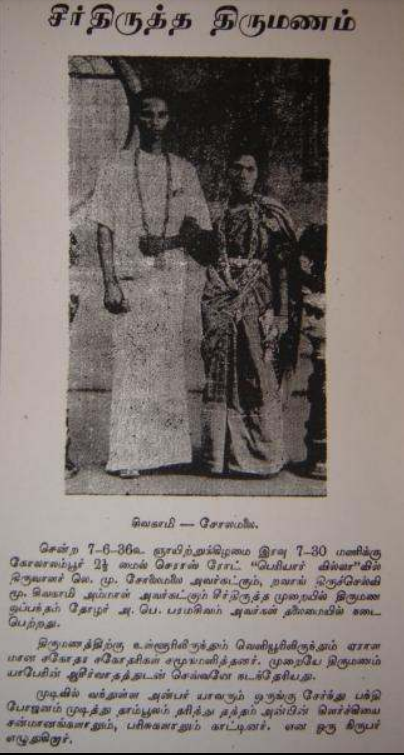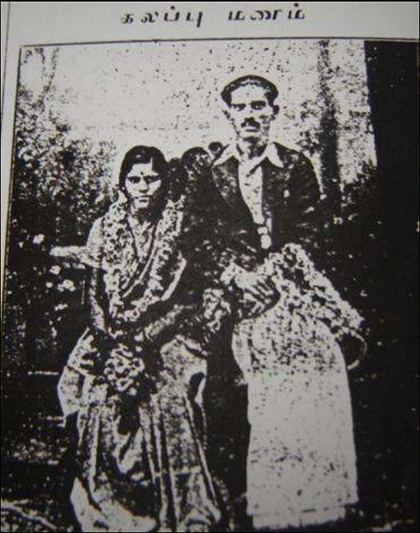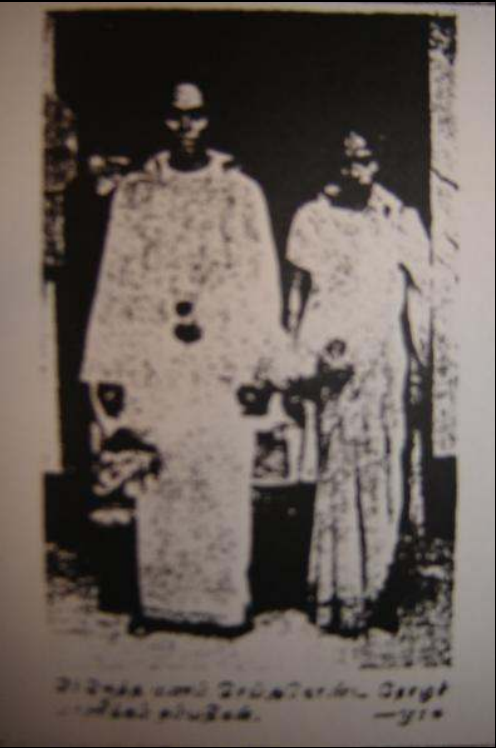【by Simon Soon, Dec. 2021】
There are number of photographs mentioned in Dinesh Sathisan’s MA thesis on the Tamil presses’ formative role in shaping Tamil cultural identity during the interwar period that continued to haunt me. These photographs were published in the Malayan newspaper Tamil Murasu around 1936. In other contexts, the photographs would have been classed under the genre of wedding portraits, taken to commemorate a matrimonial rite of passage. They are generally meant to conserve a happy occasion. In this instance, when remediated through the printing press, these conjugal performances entered into a larger social debate and sought to redefine the institution of marriage. Here, the portrait was repurposed as testimonies for love’s seldom discussed political power.

Self-Respect (cuyamariyatai iyakkam) was first espoused by E. V. Ramaswamy Naicker, who crossed the kalapani to attend the All-Malaya Tamils Conference (Akila Malaya Tamiḻar Mānāṭu) in 1929. It was here that he found an ally in newspaperman Sarangapany, who used Tamil Murasu to promote Self-Respect ideals and practice in Malaya.
Self-Respect Marriages can also be seen as an Anti-Brahmin endeavour, resisting against the increasing presence and assertions of a growing Brahmin population. By establishing Brahmin-owned hotels and temples, the newer and more exclusive community sought to perpetuate the historically oppressive varna social order that accorded them greater social privileges owing to caste-centric concepts about the purity of their birthright. In addition, as a favoured comprador class groomed into professional and economic respectability within the colonial social order, the Brahmin community were regarded as natural-born leaders of the “Indian community” by the British.
In this sense, Self-Respect marriages were conjugal challenges against fate. Included under this larger umbrella were reform marriages (dispensing the services of the Brahmin priest) and widow remarriages. The movement also promoted inter-caste marriages, advocating “kalappumaṇattāl jāti oḻiyum“ (intermarriage destroys caste).

For the Tamil majority who came to Malaya as indentured labourers in the plantation estates, the recently arrived Brahmin population therefore posed the risk of introducing an oppressive social structure that many workers thought they have escaped from by coming to Malaya. Also, it was felt that if the Brahmins were to assume leadership amongst the Indian community, this would have set back the struggle for political enfranchisement of the estate workers.
In other words, photographs found in the newspaper exist as a paradox. They appear and circulate in the medium of print capitalism that prizes transience and topicality, yet the very technology used to reproduce the likenesses of actual living humans has since the invention of photography operated on a desire for permanence.
That this was not contradiction meant to be resolved suggest that the photographs served an allegorical purpose. After all, belonging to a world in flux, many of us simply want to cling on to anything that resembles endurance, and in the idea of an enduring love, we hope to come out on the side, reborn, self-made, conscious.

Wedding portraits testifying to self-respect can therefore be thought of as didactic fables of the modern age. Small lives can now be writ large. The choice one makes at the most personal level, of who to love has larger historical ramification, where the attainment of true love also promises theological liberation, from a life dictated by the stars and the tyranny of Brahminical determinism.
Photographs in the presses magnified the forcefulness of such a claim, not by increasing the audibility of its political message but by holding out a vision of truth’s supposed timelessness. Marriage portraits stage a world outside of present time, inhabiting a past present future in which freedom is a given and transcendent. In turn, it returns the newspaper readers’ gaze, bestowing its taricanam, as reciprocation of consolation and prophecy. The term is the Tamil equivalent to darsana, through which the pictorial is recognized as animated and responsive towards our line of sight. Just as we behold the image, so too do images make demand of us. We too are in their line of sight.
Over the course of the pandemic, this moral fable on love has a staying power in its capacity to remind us of the power of image operation. Our fear that a recourse to a more two-dimensional world through various forms of digital interfaces could only amount to simulated and therefore inauthentic forms of representation and interactions that ultimately rob us of embodiment. Yet theorizing images as having the ability to shape and to intervene into our reality, complicates the platonic metaphysics that have a stranglehold on what we understand to be an image. It seems that we are only beginning to turn our backs away from the shadows of enchantment projected on the walls of the cave.
AUTHOR
Simon Soon, University of Malaya, Malaysia